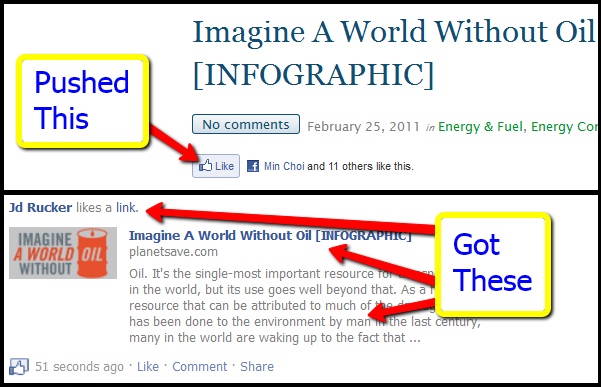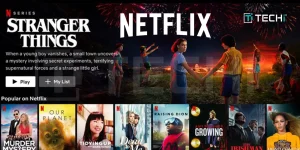Sunday, Facebook rolled out a change in the functionality of the Facebook “Like” button on websites across the Internet, essentially giving it the same basic functionality as the “Share” button. The only difference is that pushing the Like button doesn’t open up a new window or give you any way to edit what you’re posting to your wall.
It just posts it. All of it.
One click and the details are posted on your wall as well as into the streams of your friends. You cannot edit the message. Whatever the website you’re Liking has in their meta tags, that’s the message you’re posting. The end result is similar to that of the Share button, but the process removes a person’s ability to edit or personalize what they want posted to their wall.
Facebook knows exactly what they’re doing. This is a classic “bait ‘n switch” move that was well planned and executed perfectly all the way down to the exact day that it was launched.
Here are some reasons why this stinks:
No Control

The Share functionality on websites is very simple. You push the Share button. A window pops up that allows you to personalize the sharing with a comment or question, or you can leave it blank just have the title of the page you’re sharing be the top message on your post.
The Like functionality is even more simple. You push a button. No pop up. No dialogue box. No indication that anything has happened on your Facebook wall. What’s worse is that you cannot edit it at any point, neither from the page you’re liking nor on your Facebook profile itself (except in the case of the “Like with Comment” button which we cover below). Whatever message the website wants to send, you’re sending that message by liking it.
To Facebook’s credit, if you unlike the page from the source, it removes it from your wall. The reverse is also possible – deleting it from your wall gives you the ability to unlike it at the source as well.
This comes down to simplicity winning over functionality. By making it a one-click process, more pages will be shared on Facebook (in theory). There is also a one-way interaction between Like and Share buttons on the same page – Liking something counts as a Share, but Sharing something does not count as a Like.
Here’s where the functionality gets weird and a potential fix comes into play…
Some Like widgets have an option to add a comment. While it doesn’t allow full control over what is posted, it at least allows you to post a comment with your Like. The problem is that once you post that comment, it’s no longer a Like. Instead, it acts like a Share and no longer says you Liked a link. If you don’t post a comment with the same button, it shows it as a Like.
If it sounds confusing, that’s because it is.
The potential fix (and where Facebook will likely go with this) is to consolidate the process. Eliminate the Share functionality altogether by sending an update that makes the functionality the same across the board. Then, make the Like button open the comment dialogue as well as an option to “edit before posting.”
At the very least, Facebook needs to give users the option of editing the Like from their Facebook page to add a message and change the content posted from the website meta tags. Currently, you have to comment on your own post to be able to say anything.
They have an opportunity to improve this and take away the “stink factor” that will make users upset. The lack of a warning, on the other hand…
No Warning

Facebook and Google are very different from Apple and Microsoft. Apple and Microsoft normally talk about changes, additions, and products before rolling them out. Facebook and Google roll them out and then may or may not say anything about them.
This roll out is something that (from a user’s perspective) should have been announced ahead of time. There should be a message posted on Facebook once a user logs in. There should be posts about it (and no, leaking it to Mashable doesn’t count). Instead, they just made the change.
There’s a reason for this. When you want things to get attention, you roll it out Monday or Tuesday. When you want news buried, you release it late on Friday. When you want something to make an impact but without people noticing, you roll it out on Oscar Sunday, which brings us to…
The Motives

Facebook wants to be important to everyone. They have the users. Businesses are paying attention. Websites are integrating. This move works towards helping 2 of the 3. The users, who this change doesn’t help, will be told that this switch is to make things easier for them. One-click sharing is nice.
Despite what they say, this isn’t to benefit the users. Sharing was something that people consciously did when they wanted to, well, share. Liking had a nice but less prominent functionality and that was just fine for most. The challenge that Facebook faces is that Liking didn’t do much and Sharing wasn’t being used enough.
This move is all about the page views. It allows more exposure for websites, boosting the importance of Facebook integration across the board. As traffic sent to websites goes up as a result of this change, more prominence and attention will be given to Facebook as a necessary tool for exposure, promotions, and marketing.
Even the roll out day was perfect. It’s a double-dipped ice cream cone for Facebook. More sharing was likely done during the Academy Awards than on just about any day other than the Super Bowl. More importantly, people will be talking about the Oscars tomorrow and not about a minor change they barely noticed on Facebook.
The longer that people are unaware that Liking posts directly to their wall, the better from Facebook’s perspective. They don’t want people to be selective with their Likes the way they are with their Shares. The more content that is posted to walls and news feeds, the better off Facebook will be.
Overall, this was a good move from a purely strategy perspective. It’s devious and may backfire, but chances are it will succeed to some extent in every aspect. The first day of buzz has been relatively light (just as they expected). If they can make it through the week with very few people noticing, they will probably come out of this with a significant increase in traffic sent as well as overall activity on their site itself.
Damn your brilliance, Facebook!





28 User Comments
Alex
I also hate the new photo viewer 😐
Maybe if we’ll get more like’s on this page they will consider change it back 😐
http://www.facebook.com/pages/I-hate-the-new-photo-viewer/103111279767562
Max Morgan
There is one thing I’d like to correct from the article that may have an emphasis on the end thoughts. When you say, “The Like functionality is even more simple. You push a button. No pop up. No dialogue box. No indication that anything has happened on your Facebook wall”, it isn’t true. Any time you ‘like’ a page, it is posted on your wall – just with not as much emphasis as they are doing now. It has always done that and it just now having a little more functionality pushed to it in the form of an article title and image.
And I think this is a great idea, especially from the end of a user who does try and get my clients websites out through Facebook sharing. And yes, this move is all about page views – but that’s not a bad thing. It’s going to make users more aware of what their friends like. You don’t HAVE TO like things.
My quick thought.
Aaron
Allow a website to post what it wants on your wall can lead to so much abuse (i.e. spam). I suspect they will have to change the functionality to allow you to edit it or people will just stop ‘liking’ things.
Stephanie
The whole of Facebook is a “bait and switch,” just like the constantly changing privacy settings – they want and need your private data to make money. The more private, the more personal, the more useful it is to them.
Nicole
Just means another feature I wouldn’t use because I wouldn’t want to spam my friends. It’s one thing to have tiny one sentence “nascentt as liked …..” but to have entire posts for ever single news article, and web page visited and liked in a day is a bit ridiculous.
Though facebook has pretty much lost all functionality I found useful when they killed tabs. having my friendfeed, PSN and lastfm data in separate tabs to avoid spamming users was a great idea, now having to put it all in a single stream with status updates is just too spammy.